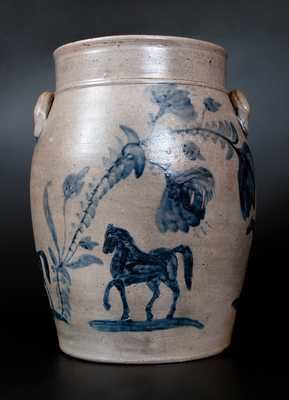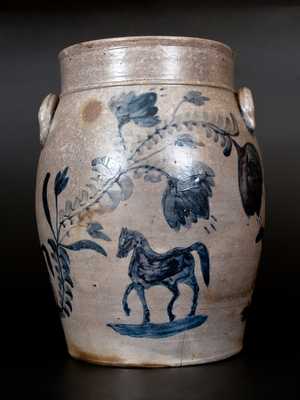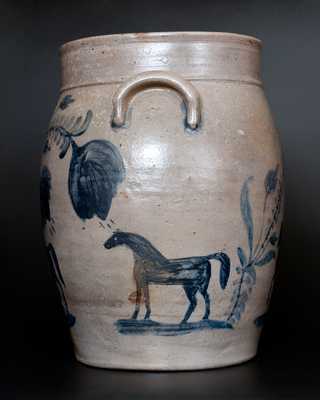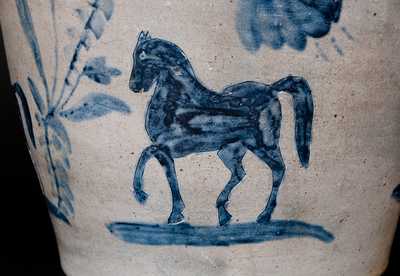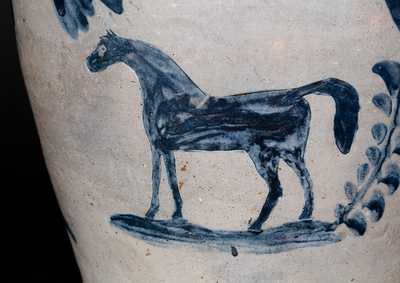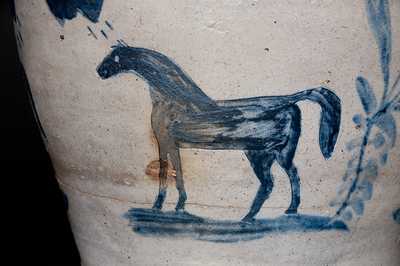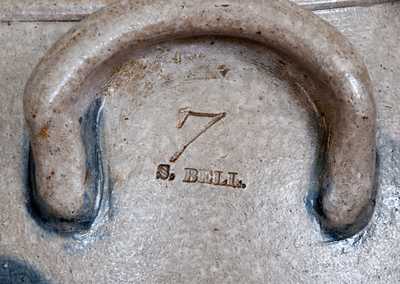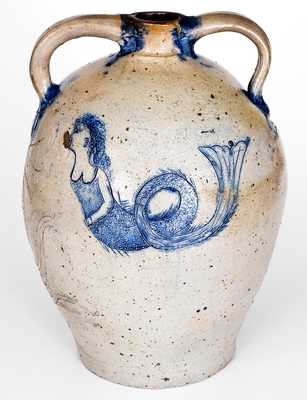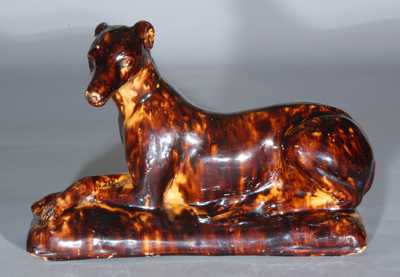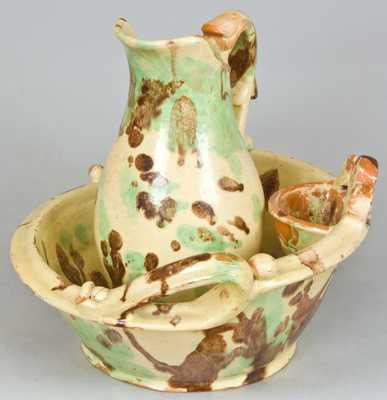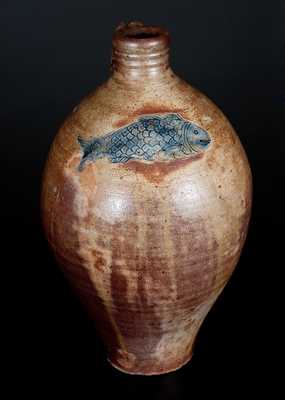Exceedingly Rare and Important Seven-Gallon Stoneware Jar with Impressed and Cobalt-Highlighted Horse Motifs and Elaborate Brushed Floral Decoration, Stamped "S. BELL," Samuel Bell, Winchester, VA, circa 1840, large-sized ovoid jar with tall collar and applied lug handles, decorated with four large impressed and cobalt-highlighted designs of standing and cantering horses around the body, further decorated on the front and reverse with elaborate cobalt floral brushwork. Stamped "S. BELL" under one handle and hand-incised "7" under both handles.
Samuel Bell was born in 1811 to potter, Peter Bell, in Hagerstown, MD. In 1824, he moved with his family, including brothers John and Solomon, to Winchester, VA, where his father established a new pottery operation. By the 1830s, Samuel was producing redware (earthenware) and stoneware at this shop. Marked pottery made during Samuel Bell's Winchester period represents some of the earliest and most-prized signed stoneware from Virginia's Shenandoah Valley. Pieces from this early production period exhibit distinctive, particularly-fine brushwork, in the form of graduated tulips extending from an upward curving stem. This decoration, which lavishly adorns the jar to be auctioned, suggest Bell was intent on producing objects of beauty and quality, which would help develop a positive reputation for the young potter. In 1843, Samuel left his father's shop, pursuing his own pottery business in nearby Strasburg, VA. His Strasburg operation, which by 1845 involved his brother, Solomon, continued to produce utilitarian household wares for nearly seventy years. Samuel Bell's role in the Shenandoah Valley potting tradition is not only evident in his surviving products, but also in the accomplishments of his potter sons, Richard Franklin "Polk" Bell, Charles Forrest Bell, and Turner Ashby Bell. Working for several decades for their father and uncle Solomon, the Bell brothers produced some of the most highly-prized examples of ceramic folk art known from the region. Samuel died at the age of eighty in 1891, a period when the family business was still vibrant, impressing its ware with the mark, "S. BELL & SON / STRASBURG", a prolific stamp used until the pottery's demise in 1913.
This stoneware horses jar, considered to be Samuel Bell's masterpiece, survives as the only example of figural-decorated stoneware known by this potter. In a broader context, decoration of this type and quality from the entire state of Virginia is considered extremely rare. The visual appeal of the horse designs is compounded by the jar's grand size, measuring seven gallons, the largest known capacity of a vessel from Bell's Winchester period of production. The method of decoration, involving two different impressed templates to form the horses' bodies, is a highly unusual treatment in American stoneware in general.
The use of alternating images of a static and mobile horse is reminiscent of early inventions in the motion picture industry, primarily the zoetrope and praxinoscope. The zoetrope, created in 1834 by British mathematican William George Horner, was a drum-shaped device, which revealed a series of sequenced images through a viewing slit. When spun, the subject of the images would come to life, revealing a figure or object in motion. While important in the development of motion pictures and animation, the zoetrope did not gain popularity until the 1860s. This device was succeeded by the praxinoscope, created by French inventor, Charles-Emile Reynaud, in 1877, which followed the same basic form and principle as the zoetrope, but improved on its predecessor by using internal mirrors for viewing instead of the external slit. Just as motion gave life to human or animal figures when these devices were spun, a sense of motion and vitality is given to the horse design on the jar when the piece is turned by the viewer. The horses appear to move around the body of the jar.
The jar's suggested moving images of the horse also recalls the pioneering time photographic motion picture sequential studies of "The Horse in Motion" by Eadweard Muybridge in the 1870s. His studies have been considered an inspiration for the invention of motion pictures. In this sense, Bell is an artist ahead of his time.
With its monumental size, artistic brushwork, and captivating figural decoration, few examples of American ceramic art have the presence of this jar. Its notoriety is evidenced by its publication and exhibition history, as well as the reproduction of its design on stoneware pieces by various 20th century potters.
This iconic work is irrefutably the finest example of Virginia stoneware to come to auction in decades, and the most important piece of Bell family pottery to come to auction since this jar sold in 1978. It also survives as arguably the most significant example of Virginia stoneware still held in private hands. It stands as a great work of ceramic art.
Provenance: Sotheby's Parke-Bernet Galleries, Feb. 1-3, 1978, lot #16; William E. Wiltshire, III Collection. Exhibited: Williamsburg, Virginia, The Abby Aldrich Rockefeller Folk Art Collection, May 25 - October 4, 1975. Literature: Illustrated and discussed in Wiltshire, Folk Pottery of the Shenandoah Valley, New York, 1975, p. 52, pl. 17; Illustrated in Ketchum, American Stoneware, p. 103. Long sealed T-shaped horizontal crack at base, continuing onto underside. Tight 4" crack from rim on side of jar. Small rim chips. A shallow 1" in-the-firing flake on interior of rim, which is glazed-over. Height 16".

